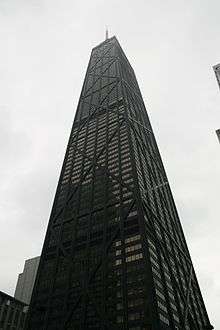Braced frame
A braced frame is a structural system which is designed primarily to resist wind and earthquake forces. Members in a braced frame are designed to work in tension and compression, similar to a truss. Braced frames are almost always composed of steel members.
Types of braced frame

Most braced frames are concentric. This means that, where members intersect at a node, the centroid of each member passes through the same point.
Concentrically braced frames can further be classified as either ordinary or special. Ordinary concentric braced frames (OCBFs) do not have extensive requirements regarding members or connections, and are frequently used in areas of low seismic risk. OCBF steel frame buildings originated in Chicago and reinforced concrete frames originated in Germany and France – areas where earthquakes were not an engineering consideration.[1] Accordingly, special concentrically or eccentrically braced frames were later developed with extensive design requirements, and are frequently used in areas of high seismic risk. The purpose of the concentrically- or eccentrically-braced design is to ensure adequate ductility (i.e., to stretch without breaking suddenly).
See also
References
- ↑ Reitherman, Robert (2012). Earthquakes and Engineers: An International History. Reston, VA: ASCE Press. ISBN 9780784410714.
- AISC Steel Construction Manual
- AISC Seismic Design Manual
- SEAOC Seismology Committee (2008). “Concentrically braced frames,” August, 2008, The SEAOC Blue Book: Seismic design recommendations, Structural Engineers Association of California, Sacramento, CA.